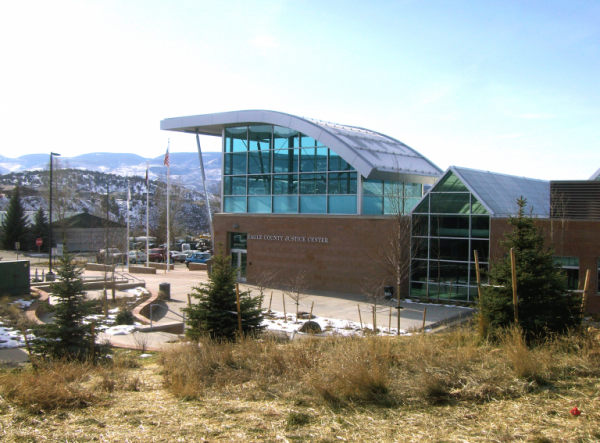Colorado DACA recipients headed to Washington to rally support for Dream Act
October 2, 2017, 1:44 pm

The Eagle County Justice Center.
Advocates for the DREAM Act to protect recipients of Deferred Action for Childhood Arrivals (DACA) are mobilizing all over Colorado to pressure members of Congress to finally act on an aspect of immigration reform threatened by the Trump administration’s hard-line stance on so-called “Dreamers.”
The efforts range from local schools reaching out to DACA recipients as a registration deadline approaches to a national immigration-reform group flying Colorado Dreamers, including two from the state’s Western Slope, to Washington to meet with members of the state’s congressional delegation.
In Eagle County, Battle Mountain High School in Edwards is counseling its DACA recipients.
“Battle Mountain staff support the Dreamers and participants of DACA,” according to a recent Battle Mountain High School newsletter. “If your permit is expiring before March 5, you need to reapply by Oct. 5 [Thursday].”
The national tech-industry immigration reform lobbying group FWD.us recently declared Oct. 5 a national DACA Day of Action, urging people to call members of Congress and push for the passage of the bipartisan Dream Act, which would permanently protect Dreamers and is co-sponsored by both GOP Colorado Sen. Cory Gardner and Democratic Sen. Michael Bennet.
“Support for a legislative solution like the bipartisan Dream Act is growing across the country, from new polls showing 86 percent of the American people support protecting Dreamers to high-profile Rep. Joe Barton (R-TX) signing on to the bill,” Alida Garcia, director of coalitions and policy for FWD.us, said in a release. “But we need to keep the pressure on every member of Congress to pass the Dream Act now.”
Also this week, more than 100 Dreamers from 25 states, including five from Colorado, will participate in a FWD.us fly-in event, traveling to Washington to lobby their members of Congress to pass the Dream Act. The Dreamers come from diverse backgrounds and work in a wide variety of fields, including education, engineering, social advocacy, medicine and science. They’re all active in their communities, in churches, as mentors and on sports teams.
Meanwhile, ski towns across the West are grappling with how best to cope with the federal immigration crackdown, prompting calls for a county resolution on the topic in Eagle County. Park City, Utah, and Aspen have also made headlines on the topic recently.
An ordinance limiting cooperation with federal immigration authorities may be a slam dunk in a city like Denver, but in ski towns like Vail, Aspen and Park City – reliant to some degree on deep-pocketed visitors from deep in Donald Trump country – opposing ICE can be risky business.
Aspen Skiing Company CEO Mike Kaplan recently took that risk, speaking out on Facebook against the administration’s decision to end the DACA program in six months – a stance that generated significant support but also some calls for a Trump country boycott of Glitter Gulch.
And in a recent Wall Street Journal column, Kaplan cited a 30-percent drop in visitation by Mexicans last ski season compared to the previous season, blaming the “xenophobia radiating from the Oval Office.”
In deep red Utah, Park City Mayor Jack Thomas last month boldly stood up for the program that protects so-called “Dreamers” – illegal immigrants brought here at a young age – by sending out a newsletter urging residents to practice tolerance and supporting a pro-DACA city resolution.
“Another reason to get to know your neighbors is to better understand the human toll that reversing some of our most humane and productive immigration policies would take,” Thomas wrote, calling “recent efforts to dismantle DACA … disturbing.”
But in Vail, where Mayor Dave Chapin and other town officials have repeatedly expressed support for immigrants and the “Trump Slump” has been downplayed as a factor in decreased Mexican visitation, there’s disagreement over just how far local law enforcement should go to cooperate – or not – with federal immigration officials.

Vail Police Chief Dwight Henninger
Vail town prosecutor Inga Causey, who also has a private practice representing victims of domestic violence and sexual assault, helped set up a group called the Community Trust Project to push for an Eagle County resolution clearly spelling out local law enforcement’s role in the ongoing federal immigration crackdown.
She says it’s needed to ease fears because undocumented residents aren’t showing up as witnesses or even reporting crimes because they’re afraid local police will turn them over to ICE.
“There are cases that we have to dismiss because we don’t have witnesses,” Causey said. “The fear is still there. There’s a greater visibility of ICE agents at the courthouses, but that’s not all that’s occurring. I’ve had jury trials scheduled where I have undocumented witnesses that I needed to continue with prosecution of a defendant, and they’re not coming.”
Since January, Causey has been advocating for an Eagle County resolution clearly stating that local police will not enforce federal immigration laws or do more than the bare minimum to inform ICE that undocumented people have been arrested for low-level misdemeanor offenses. And she wants a concerted, community-wide effort to inform people about the resolution.
But Vail Police Chief Dwight Henninger doesn’t think such a resolution is necessary – mainly because he feels like it’s already been done. In February, the Eagle County Sheriff’s Office and other local police agencies posted a statement (pdf) in both Spanish and English.
“We have seen some instances where people have been fearful, and that’s what we were trying to address in our statement,” Henninger said. “It doesn’t reach the level of a governmental, resolution-making decision, and I’m not sure that’s as critical maybe as Inga and her group feel it is, but I could be totally wrong on that issue.”
Hispanics or Latinos made up just under 30 percent of Eagle County’s population of nearly 54,000 in July of 2016, according to the U.S. Census Bureau, with foreign-born people making up 19 percent of the population between 2011-15. That’s one of the highest foreign-born populations in the state, according to a recent analysis.
While supportive of immigrants in Eagle County, Henninger says none of the Vail Valley’s towns are sanctuary cities because they’re all tied to the policies of the Eagle County Detention Center in Eagle, which is run by the Eagle County Sheriff’s Office.

Jill Ryan
The policy there is to notify federal immigration officials whenever a foreign-born person from any country in the world – not just Mexico or other parts of Latin America – is arrested and detained at the Eagle County jail.
In the wake of persistent reports of increased ICE presence since January and recent busts in Eagle and Garfield counties, Sheriff James Van Beek told RealVail.com that everyone is treated equally by the justice system in Eagle County – a position he reiterated in a recent column in the Vail Daily.
Henninger and Van Beek both cited the long-running Immigrant Advisory Council, launched in conjunction with Catholic Charities, that communicates the policies and practices of local police to Spanish-speaking residents through a variety of techniques, including church meetings and other types of gatherings.
The council works with local nonprofits and groups such as Eagle County Schools, the Salvation Army, Bright Future Foundation, YouthPower365 and Eagle County Victim Services. Causey lauds those groups but says more needs to be done to facilitate cooperation with local police.
“They may reach out to Catholic Charities or the Bright Future Foundation, but even then, trying to get them to contact law enforcement is very difficult, and the longer they wait the more difficult it is to prosecute those crimes – sex assault, domestic violence,” Causey said. “They require kind of an immediate police contact so that the investigation can occur quickly.”
One of the reasons the universal county resolution idea stalled – with actual action items to increase communications – is that local law enforcement wants to retain its right to notify ICE when extremely violent offenders are detained.
“I don’t think there’s anyone in any community who feels like people who are violent criminals should be allowed to stay in this country when they have both the criminal violation and an immigration violation,” Henninger said, “so I think we’re all supportive of getting those people out of the country.”
Causey is fully supportive of notifying federal immigration officials in those instances, but she argues federal pressure may have more to do with the lack of a cohesive, countywide resolution.
“[Federal pressure has] been something that obviously has been on the minds of all law enforcement, and quite frankly that becomes the difficult thing, that they want to do something to help their community – in their minds to make it safer – but, yes, there is fear that funding will be pulled,” Causey said.
Even though Eagle County, working with the sheriff, has already passed a general resolution of support for immigrants, Eagle County Commissioner Jill Ryan says she would likely back a more specific resolution. She confirmed local law enforcement is nervous about federal reaction.
“I think that the sheriff is afraid to lose federal funds because that’s been made a threat,” Ryan said. “In my view, I just don’t think it’s local law enforcement’s job to enforce federal immigration law, and I would go so far as to say I don’t even believe we should be helping them at all.”
Ryan said there are other steps the county can take to ease fears in the immigrant community.
“One response that we have had as a county is we have a new position that we’re getting ready to hire and it’s a community outreach worker and their purpose is really to have a position solely dedicated to outreach to the Latino community,” Ryan said.
Henninger says comprehensive, federal immigration reform is necessary, and that “until we fix that problem, these are just Band-Aid kinds of things trying to deal with them.” In the meantime, his department will continue to work with the local immigrant population.
“We work very hard in Eagle County, all law enforcement agencies do, to build relationships with our communities — and that’s all the communities,” Henninger said. “A large portion of our county is Hispanic and is here working hard and doing a good job, making our community successful.
“I wouldn’t want anything to derail that, and I think the national rhetoric is clearly making people less comfortable with law enforcement, and that’s one of the primary reasons we as a group decided to put out that statement [in February],” he added.
Here’s contact information for Colorado’s congressional delegation:
Senate
Michael Bennet, Democrat
261 Russell Senate Office Building
Washington DC 20510
(202) 224-5852
Contact: www.bennet.senate.gov/?p=contact
Cory Gardner, Republican
354 Russell Senate Office Building
Washington DC 20510
(202) 224-5941
Contact: www.gardner.senate.gov/contact-cory/email-cory
House of Representatives
District 1 – Diane DeGette, Democrat
2111 Rayburn House Office Building
U.S. House of Representatives
Washington, DC 20515
(202) 225-4431
Contact: https://degette.house.gov/contact
District 2 – Jared Polis, Democrat
1727 Longworth House Office Building
U.S. House of Representatives
Washington, DC 20515
(202) 225-2161
Contact: https://polis.house.gov/contact/
District 3 – Scott Tipton, Republican
218 Cannon House Office Building
U.S. House of Representatives
Washington, DC 20515
(202) 225-4761
Contact: https://tipton.house.gov/contact/email
District 4 – Ken Buck, Republican
1130 Longworth House Office Building
U.S. House of Representatives
Washington, DC 20515
(202) 225-4676
Contact: https://buck.house.gov/contact
| District 5 – Doug Lamborn, Republican2402 Rayburn House Office BuildingU.S. House of Representatives Washington, DC 20515(202) 225-4422Contact: https://lamborn.house.gov/contact/District 6 – Mike Coffman, Republican 2443 Rayburn House Office Building U.S. House of Representatives (202) 225-7882 Contacts: https://coffman.house.gov/contact/ District 7 – Ed Perlmutter, Democrat 1410 Longworth House Office Building U.S. House of Representatives (202) 225-2645 Contacts: https://perlmutter.house.gov/forms/writeyourrep/
|
Related Posts:
- Front-runner Trump sets tone for GOP field on… Former President Donald Trump Most of the candidates in this…
- Colorado's Bennet part of bipartisan group working… A Texas National Guardsman observes as Border Patrol agents pat…
- States increasingly offering health care coverage… A small fence separates densely populated Tijuana, Mexico, right, from…
- Colorado senator urges Supreme Court to hold Trump… Wiki Commons photo EAGLE, Colo. — Colorado U.S. Sen. John…
- Bipartisan group dismayed at lack of debt debate as… If you’re financially managing a household, you likely already know…
Latest posts by David O. Williams (see all)
- During National Small Business Month, Target, DreamSpring put funding bullseye on underrepresented communities in Denver area - May 29, 2025
- Colorado senator urges Supreme Court to hold Trump administration in contempt on deportations - April 19, 2025
- Conductor who brought back Colorado ski train wants to use rail to save state’s highways for skiing - March 20, 2025
Recent Posts
- Wildfire experts across West ‘very concerned’ as feds cut funds, staffing ahead of dry, hot summer June 11, 2025
- During National Small Business Month, Target, DreamSpring put funding bullseye on underrepresented communities in Denver area May 29, 2025
- Colorado senator urges Supreme Court to hold Trump administration in contempt on deportations April 19, 2025
- Conductor who brought back Colorado ski train wants to use rail to save state’s highways for skiing March 20, 2025
- Democratization or ruination? A deep dive on impacts of multi-resort ski passes on ski towns February 5, 2025
- Western Rail Coalition looks to revive passenger rail service on long-dormant line connecting Colorado mountain towns January 22, 2025
- Colorado ski town looks to dig deep, diversify energy sources as climate change threat looms January 10, 2025
- State of Colorado strikes deal with Union Pacific to increase passenger rail service through Moffat Tunnel December 27, 2024
- Colorado-Utah battle over oil trains could wind up tied in U.S. Supreme Court following recusal December 12, 2024
- Texas rail company eyeing Colorado passenger service no longer involved with Utah oil trains November 15, 2024


You must be logged in to post a comment Login